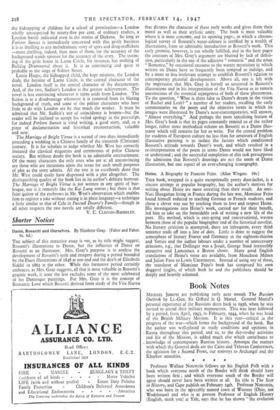Shorter Notices
THE subject of this attractive essay is not, as its title might suggest, Rossetti's illustrations to Dante, but the influence of Dante on Rossetti as an illustrator. Mrs. Gray's purpose is to analyse the development of Rossetti's style and imagery during a period bounded by the Faust illustrations of 1848 at one end and the death of Elizabeth Siddal in 1862 at the other. While this formative period certainly embraces, as Mrs. Gray suggests, all that is most valuable in Rossetti's graphic work, it none the less excludes some of the most celebrated of his Dantesque paintings. For Mrs. Gray it is the concept of Romantic Love which Rossetti derived from study of the Vita Nuova
that dictates the character of these early works and gives them their moral as well as their stylistic unity. The book is most valuable where it is most concrete, and its opening page:, in which a chrono- logical survey of Rossetti's water-colours is fortified by a wealth of illustrations, form an admirable introduction to Rossetti's work. This early promise, however, is not wholly fulfilled, and in the later pages the contours of Mrs. Gray's argument are blurred by lack of defini- tion, particularly in the use of the adjective " romantic " and the nOun "Romance," by occasional recourse to the watery mysticism in which writers on Dante have so frequently been tempted to indulge, and by a more or less irrelevant attempt to establish Rossetti's relation to contemporary pictorial developments. Above all, one is left with the Impression that Mrs. Gray is herself so saturated in Rossetti's illustrations and in his interpretation of the Vita Nuova as to remain unconscious of the essential strangeness of both of these phenomena. To the question, "What is there false to Dante's dream in the vision of Rachel and Leah?" a number of her readers, recalling the early commentaries on the poem and the objective terms in which its images were illustrated by Dante's near-contemporaries, will answer, "Almost everything." And perhaps the most tantalising feature of Mrs. Gray's book is that its pages constantly remind us of the rather longer, rather more methodical volume on Rossetti as a Dante illus- trator which still remains for her to write. For the central problem for students of European culture no less than for amateurs of English illustrative painting is to isolate the factors which conditioned Rossetti's attitude towards DantFs work, and which resulted in a re-interpretation of the poem in terms Dante would not have liked or understood ; and the successful completion of this task presupposes the admission that Rossetti's drawings are nct the norm of Dante illustration, but one aspect of an ever-changing iconography. _


































 Previous page
Previous page